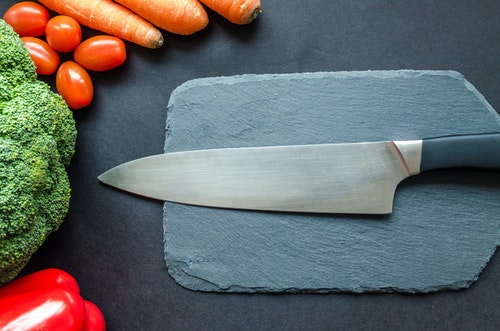We have reviewed that a sharpening rod is preferable for sharpening serrated kitchen knives.
Just like ordinary kitchen knives, sharpen serrated knives also get dull. It is best to understand the appropriate ways to sharpen a serrated knife since it helps the user save you from frustrations and time wastage in your kitchen. It is challenging to restore their sharpness without changing the edges compared to straight-edged knives. It is crucial to sharpen only when you note your serrated knife is less effective, mostly during slicing crusty loaves of bread. A sharp serrated knife ensures perfect and quicker cutting.
What is a serrated knife?
A serrated knife is a cutting instrument consisting of a tooth-like edge and a scalloped blade with a handle. It is different from the ordinary chef’s knife due to its distinctive appearance of a scalloped blade. It normally has serration on each scallop point with tiny points along the tool cutting edge.
Additionally, the serrated knife is ideal for cutting through foods with soft interiors and hard exteriors: bread and cakes. A saw has a similar concept principle to a serrated knife. The knife has teeth on the blade, whereby when using the knife, you will need to rip the knife smoothly, sliding through the food.
Various ways how to sharpen serrated kitchen knives
Using a Sharpening Rod
A sharpening rod is similar to honing steel, though it’s smaller and narrower in size. It can taper to a point; this means that it can offer multiple thicknesses along the rod’s shaft. Knife users consider it helpful since the serrations have different widths in different knives. Today, sharpening rods are available in ceramic, steel, and diamond in the market.
During sharpening, the rod section fitted on the serrations. You will need to drag the rod across the serrations. Consider keeping the rod flush to the slope, and then you will have the right angle to sharpen the knife.
It is important to give each serration four to five strokes before proceeding to the next one. Considering the number of your knife serration will determine the time to get it done.
Once you are done, flip your knife over and also give the flat side of the blade some strokes on a regular sharpening stone. The step is ideal for making the burr smooth that was raised on your knife’s edge.
Finally, clean your knife and dry it.

Using a triangle-shaped sharpener
It is similar to a rod but has tapered triangles designed specifically for serrated knives. The shape of this sharpening tool normally works best for knives with V-shaped gullets. The sharpening steps are similar to the sharpening rod method procedures described above. The difference between the two is that the triangle-shaped sharpener will require you to rock the edge of the sharpening tool back and forth, essentially along the angle, instead of considering rotating it.
Using a square stone
The use of this tool is more challenging, more so it is very unreliable though it is possible to sharpen your serrated knife. During sharpening, you will be required to hold the knife’s spine carefully against a harder surface and then tilt your knife’s blade so that the beveled edge will appear on top.
Consider bringing the corner of the sharpening stone closer to the scalloped edge and then use it to sharpen the edge, moving it back and forth to cover all the areas of the scallop.
Making your sharpening tool from emery cloth and dowels
If you don’t want to buy a single-purpose sharpening tool, you can consider purchasing dowels that are relatively cheaper from the local hardware store in your area.
It would be best if you considered purchasing a dowel that fits your knife’s first scallop without considering wobbling, then wrap a piece of emery cloth around the dowel.
Further, hold the cloth with your finger and then start the sharpening process slowly and carefully. Then switch the dowels to make sure they match the size of scallops moving along the knife.
For serrated knives, consider using a round dowel for a knife with round scallops and a square dowel for V-shaped scallops.
Using Diafold serrated sharpener
Normally made for small serrations since the rod tapers down to the end, therefore can fit multiple sizes. After purchasing the tool, ensure you consider sharpening each serration on your knife individually about four to five times. It can be time-consuming but very necessary for your serrated knife.
You will need to take the sharpener perpendicularly to the beveled edge, ensuring you line it well so that the size of the rod on the tool fits perfectly along with the serrations.
Further, consider pulling the knife lightly back and forth over the serrations.
Stop after a few motions, and then check your knife to see if there is a burr on the backside of the blade. If you feel the burr, it means you are done, and you can move on to the next serration.
After you are done with all the serration, turn the knife over to remove the burr carefully, so you don’t injure yourself in the process.
Conclusively, in case you are wondering about the best possible way to sharpen your serrated kitchen knife, worry no more since we’ve got you covered. We can comfortably share that a use of sharpening rodis the most recommendable way of sharpening your serrated kitchen knife through research and practice. This is due to its ability to taper to a point, which means that it can offer multiple thicknesses along the rod’s shaft. Knife users consider it helpful since the serrations have different widths in different knives. Today, sharpening rods are available in ceramic, steel, and diamond with advanced technology.
Moreover, a sharpening rod is easier and faster than the other way explained in this article. The main key to the sharp serrated knife is maintenance; this can be either proper usage or storage of the knife.


